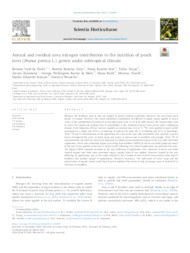Annual and residual urea nitrogen contribution to the nutrition of peach trees (Prunus persica L.) grown under subtropical climate.
Annual and residual urea nitrogen contribution to the nutrition of peach trees (Prunus persica L.) grown under subtropical climate.
Author(s): PAULA, B. V. de; VITTO, B. B.; SETE, P. B.; TRAPP, T.; ZALAMENA, J.; MELO, G. W. B. de; BALDI, E.; TOSELLI, M.; ROZANE, D. E.; BRUNETTO, G.
Summary: Nitrogen (N) fertilizers such as urea are applied to peach orchards worldwide whenever the soil cannot meet plants? N demand. However, the actual nutritional contribution of different N supply modes applied to peach crops, or the contribution of residual N in the subsequent cycle, is yet to be fully known. The current study aims to assess the annual and residual urea N contribution to the nutrition of peach trees grown under subtropical climate. Forty kilograms of N per hectare supplied as enriched urea (3.0 at. % 15N), were applied to peach in full production at a single rate (100 % at budding) or split in two rates (50 % at budding and 50 % at flowering). Total 15N and N concentrations in the application year and in the year after treatments were assessed in peach leaves throughout the cycle, in fruits (pulp and stone) at harvest and in stratified soil samples. Total 15N, N concentrations and total dry mass were measured in annual and perennial tree organs in the year after treatment application. Peach trees evidenced higher N deriving from fertilizer (NDFF) in leaves and fruits (pulp and stone) in the year N was applied to the soil, as well as in the following year when N application was split into two rates. The highest NDFF amounts recorded in the year following N application were observed in leaves and fruits (annual organs) and thick roots (perennial organ), mainly when N was splitted. However, mainly in the year following its application, due to the small residual N, the N found in trees derived from sources other than N fertilizer; this justifies annual N applications, whenever necessary. The cultivation of cover crops and the preservation of organic matter could help N peach nutrition that seems to take advantage more of residual N in soil than on fertilizers.
Publication year: 2021
Types of publication: Journal article
Unit: Embrapa Grape & Wine
Keywords: 15N isotope, Fruit farming, N distribution, N fertilization, Orchard
Observation
Some of Embrapa's publications are published as ePub files. To read them, use or download one of the following free software options to your computer or mobile device. Android: Google Play Books; IOS: iBooks; Windows and Linux: Calibre.
Access other publications
Access the Agricultural Research Database (BDPA) to consult Embrapa's full library collection and records.
Visit Embrapa Bookstore to purchase books and other publications sold by Embrapa.

